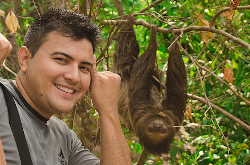아마존 동물과 셀프카메라

Visitors to the Amazon rain forest in South America face different rules for how they can interact with wild animals.
A new report issued by the animal rights group World Animal Protection says that animals suffer when they are kept in captivity so that tourists can touch and photograph them. The report is called “A close up on cruelty: The harmful impacts of wildlife selfies in the Amazon.”
The group’s wildlife adviser, Neil D’Cruze, told the Associated Press, “We want tourists visiting the Amazon to know that if they care about wildlife, they should not use animals as photo props on their vacation.”
Animals presented to visitors for photographs are often taken from their natural environments and kept in poor conditions, D’Cruze says. He added that animals that are touched and handled by many visitors each day can be harmed and experience stress.
D’Cruze says a solution to the problem is to better educate travelers.
He supports programs like Instagram’s new campaign against “selfie” photographs with wild animals. Instagram users that search for hashtags such as #slothselfie now see the warning: “You are searching for a hashtag that may be associated with posts that encourage harmful behavior to animals or the environment.”
The travel website TripAdvisor last year stopped organizing tours in which travelers have physical contact with captive or wild animals.
National Geographic reporter Natasha Daly traveled to the Amazon earlier this year. She found that officials in Manaus, Brazil, have been actively preventing the use of wildlife as props for tourists.
She said, “By the time I was there in mid-August, a lot of tour operators had stopped going to locations where the animals are brought out.”
But she found that such practices continue in Puerto Alegria, Peru. Tourists beginning their Amazon trips from nearby Leticia, Colombia, often spend time in Puerto Alegria. Daly said she saw 20 kinds of animals brought out for tourists there in three days.
Daly said visitors likely would not get a chance to see the Amazon’s famous, elusive wildlife without guides showing them captive animals. Day trips where sloths, snakes and other animals are presented to tourists for photos make it easier for visitors to see them.
But she said educating travelers about these issues may change their behaviors, especially among animal lovers who may not realize the harm in touching and photographing creatures.
“As soon as an activity crosses the line from observation to interaction, it’s probably going to be bad for the animal.”
Many national parks in the Brazilian Amazon have policies for how tourists and guides can interact with animals. For example, the Anavilhanas National Park has rules that limit contact with the area’s famous freshwater dolphins.
Te Batista has been a guide on the Rio Negro, which passes through the park, for 20 years. He says he feels there is a difference between observing animals in the wild and in captivity.
“When tourists tell me, ‘I want to take the kinds of pictures I’ve seen on social media,’ I tell them they have to understand that those were taken with animals in captivity,” he said.
Sometimes, he said, he might pull a caiman crocodile out of the water for a few minutes to show it up close.
“Within 10 minutes it will be back in the water,” he said. “It’s a different thing if that caiman is in captivity.”
Some Brazilian officials say outside organizations should not be able to tell local tourism organizations how to operate.
Vinicius Lummertz is president of Embratur, Brazil’s tourism board. He said it would be impossible to observe and control tourists’ contact with animals across such a large territory.
Brazil is larger than the mainland United States. The Amazon basin makes up about 60 percent of Brazil’s territory.
Lummertz said, “This is a developing country that needs resources for education, health care, and then the world expects us to police the touching of a caiman on the head in an area about 60 percent the size of the United States? It’s not possible.”

